In 2000-2001 analogue film sales sat tat an all time high. Film was king and draw into digital in was yet to happen. But this was the hightide mark. Sales would never be as good. Whilst Film was to have a few more years in the sun the digital would rapidly erode the market. But in 2000 Canon produced the PowerShot G1, a camera that showed the writing was already on the wall.

The PowerShot G1 is Canon’s first prosumer compact and the first of the still running G series. This camera has features missing on cameras I’ve shot quite a few years older than it. And frankly other than a small zoom and the sensor, it has a feature list that not all compacts offer today.
Digital Conversion
Canon sat well placed to enter the digital market. It’s SureShot series of 35mm compacts was a dominant early player in the rise of the AF compact. And Canon would retain a sizeable chunk of the market into this century. They had also mastered APS compact design with the IXUS series. These lines would morph into the PowerShot and the compact Digital IXUS series respectively.

Like the SureShot series before the PowerShot series straddles the entire gamut of digital compacts. From Prosumer models like the G1 down to entry level models you could pick up off the shelf in supermarkets.
But the late 1990’s there was a sea of digital camera on the market. These were not just from old Japanese rivals like Nikon and Olympus. There were new rival from consumer electronic companies like Casio, HP and Today’s major players Sony & Panasonic.
Rivals had already got there with their prosumer models. But the old boy was about to fight back in style.
Design of the PowerShot G1
We’ll get to under the hood in a mo. For a turn of the century digital when wacky design was the norm, the G1 looks quite conventional. For example Nikon’s Coolpix 990 looks like the mutant lovechild of a webcam and Rubik’s cube. This looks reassuringly solid and normal. The camera has a lens cap but oddly without an accessory is not filter threaded.
And credit due, this actually looks like something you want to hold today. This looks like a conventional 35mm compact until you spin it around to rear. It’s stock, well-built and a tad hefty at 420gms. The frontplate and protuding lens barrel are metal, the rest is plastic. But the G1 is well built stuff.
Top plate feature a Monochrome info LCD. This is large and clear but not backlit. On the other side of the flash mount sits the shutter button. It has a with a typical zoom collar. A mode dial behind plus a button to switch on continuous shooting or turn on the timer/remote use. The continuous shooting is pedestrian. With jpeg files 1.7fps – if you turn rear screen off.

Screen Queen
The rear LCD is a standout for this era. It is a big for the time 1.8″
113.578 Pixel LCD which is quite the thing. This bright enough (to just) see in bright light when cameras I’ve used 5 years or more newer struggle. The Screen is also fully articulated – about a decade before it was common on SLR and CSC. The 270° vertical and 180° horizontal arcs of movement allow you to use for pretty much any angle including selfies.
Around the LCD you get the usual jog dial and buttons. There’s dedicated buttons to switch flash modes, spot metering, macro. Other buttons have multiple features. There is is also a zooming diopter correctable viewfinder
Under the hood of the PowerShot G1
Sensor and lens
The camera features a 3.34 Megapixel (MP) 1/1.8″ CCD. That might sound small against the current crop of premium compacts with 1″ or APS-C sensor. But it’s still bigger than the sensor you find on your phone or the 1/2″-1/2.3″ sensor on a budget compact. And remember we’re talking a 2000 camera here.

The sensor sits behind a 7-21mm 1:2-2.5 lens with 7 element in 6 groups. This gives a x3 optical zoom ( common in upper end cameras of the era). It equates to a 34-102mm lens on a 35mm camera.
AF is provided by a TTL system. Although not specified, this is a single AF point camera. The focus range in most modes is 70cm to infinity at any lens length. But Engage macro you can get as close as 6cm (wide- although the tele can only go to 20cm). Focus lock and manual focus system are available in some modes. You have the option to switch between continuous and single AF.
But Is it a New Lens ?
Interestingly DPReview in their review in 2000 queried that the lens seemed to be the same construction as other cameras. The lens on the Epson PhotoPC 3000Z & Sony DSC-S70 are near identical. That not an outlandish suggestion. We know various companies provided produced cameras and parts for other names. So it’s not beyond the realms of possibility that Canon (or a third party) made the lens for all 3. What likely differs is the glass and any coatings. I’ve ordered the Sony for about £20 so we’ll see.
Metering & Exposure
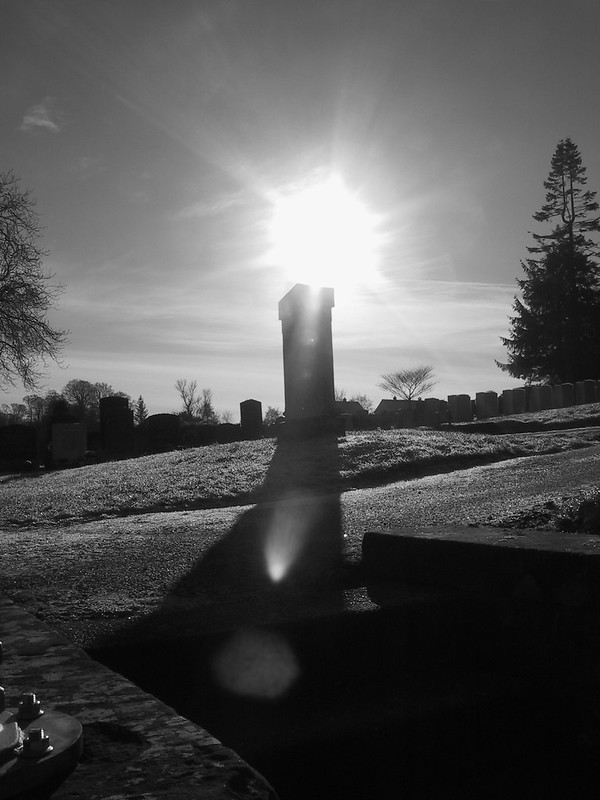
The camera offers centre-weighted metering by default with optional spot metering. Whilst this isn’t unusual for the time I did find it odd for such a premium camera. Canon had been putting matrix metering into their SLR cameras for years. My Entry Level EOS 1000F from 1990 has 3 zone metering. That said it generally worked well although backlit subjects could be an issue as for any other non matrix metered camera.

Aperture and shutter use the same mechanism. This as we’ll see causes issues. The aperture range is good with a range from f/2 to f/8 in 1/3 steps in Aperture priority mode (Av). On paper you have shutter speeds from 8sec to 1/1000 again in 1/3 stops. But the linked shutter means you cant use any speed faster than 1/500 unless the aperture is at f/8.
The camera has built in long exposure noise reduction if shots are over 1.3 second long. You can’t disable it so I can’t compare. But low light long shots seem better than I had assumed so it does seem to work.
ISO Options
ISO ranges from 50-400 ISO. Most modes either default to 50 ISO or auto (the camera selects between 50 &100 ISO). The 50 ISO is a little unusual but as we’ll see a big plus. The range beyond is pretty typical for a higherr end compact of the age. You can EV adjust in 1/3 stops between EV ±2 and there is an auto bracketing option. Likewise flash EV is adjustable. There is a single button that cycles between these 3 setting and white balance on the rear. You also get a dedicated meter lock button

Power
The camera interesting is one of the first digitals to use a rechargeable battery the BP-511. That battery is so good, it remained a mainstay for Canon. My 2005 EOS 300D uses it as do all PowerShot G models up to the G6. The camera arrived with a high capacity Third party BP-511A (the A model is just a revised version). A CR2016 battery keeps setting data whilst the main battery out charging.
I never manage to exhaust my 3rd party battery around 130 shots to a CF card used in mixed fashion The earlier DPreview gave a life of 250 shots using a more power draining microdrive CF. That of course was using a branded battery so my 60% performance is about what I’d expect from a cheap 3rd party battery.

Storage & Flash
The fact this model accepts not just type 1 standard compact flash. It also takes the type 2 card (i.e microdrive). This was pretty jaw dropping for a compact back in 2000. It’s moot point in 2021 as you can buy cheap CF cards with 1+GB storage for not much. The camera uses the FAT file system so there’s little point in using a bigger than 2 GB card. My 4GB card worked fine but the camera could only format 2GB due to the FAT limitation. Still with an average shot size of ~780KB* that still leaves room for over 2,000 shots
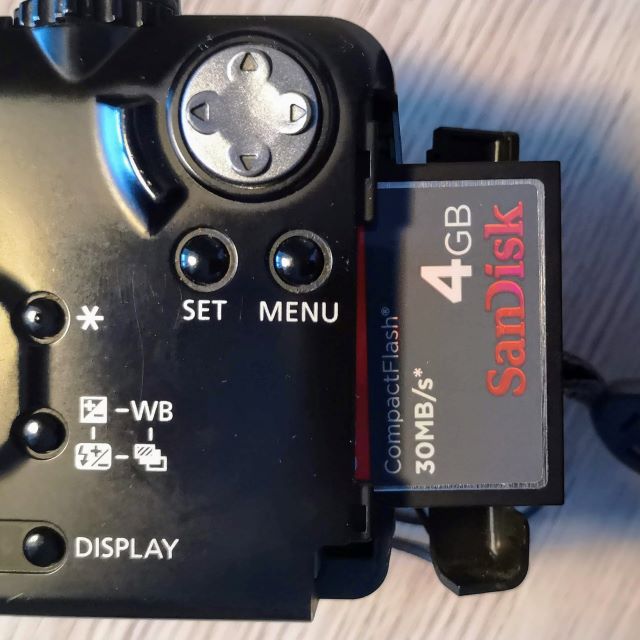
You get a built in TTL flash with range of 70cm-4.5m @100ISO at wide, (shorter on Tele (70cm-3.6m)). But the camera supports E-TTL speedlights by an accessory shoe. It supports to varying degrees the Canon Speedlite EX series. The manual mentions the 220EX, 380EX, 420EX & 550EX models. But others will likely be supported. Be wary of using a non dedicated flash here as there is official maximum trigger voltage of around 6volts. You can seriously fry a camera’s electrics so beware (see here for more advice)
Built in Flash is okay. With 3 m plus range, it actually outperforms than many a film compact. All the usual issues apply and it’s nice to see an option to go external.
Mode dial
The dial is 2 ring affair. There is a collar which moves from the camera on, off, playback and PC connection setting using the proprietary cable. I have no idea how well it inks on a modern PC. I just got the camera and a battery so can’t test that.
The inner mode dial is pretty typical for a prosumer camera. If you don’t want to do much thinking stick it in auto. Canon divide the other options into Creative (more user control over settings) and Image Zone . The latter are a set of basic easy shoot prefined modes.
Creative modes
If you’ve shot SLR/dSLR that aren’t made by Canon or Pentax you’ll know these as the PSAM options. They give you more control over settings and are rarely seen on more low level cameras. You get 4 modes. Program AE (P) is similar to auto. But you can adjust more setting such as wider ISO. And use features like spot metering and Auto exposure Bracketing (AEB). The other modes give similar wider features but the ability to control exposure settings. You get off course Shutter Priority (Tv), Aperture priority (Av) and Manual (M). Manual does not support so options like AEB or spot metering
It’s good to see these but you have a minimal aperture of just f/8. There is also that weird f/8 shutter speed thing. I tended to shoot in either Auto or P mode rather than my usual aperture priority.
Imaging Zone modes
Turn the other way and you get predefined modes. The first is Pan-focus. Here the lens gets locked with fixed focus. The principle was this reduces lag time for quick snaps. Beyond that you have portrait mode, landscape, Night Scene (aka Slow sync flash), B&W, Stitch Assist (multi-frame panoramas) and movie. The stitch assist feature which is commonplace now doesn’t produce a stitched panorama in camera. The setting helps line up a set of standard shots. Bundled software was need to stich the shots together on your computer later.
Movie mode was limited to 30sec burst at 320×240 @15fps. Doesn’t sound great by today’s standards but typical of the time. Audio recording was included which not all camera had.
Landscape and oddly the B&W mode proved most useful to me. Otherwise it was P or Auto.
Menu
Menu options are mode dependant. You can only set ISO in some modes for example. These are accessed by hitting the menu button on rear with the LCD display on. You can use 2 menu columns.
Set up deals with time & date setting, your language, video system (Pal/NTSC) and card formatting. You can also turn off the annoying beep which serves as shutter noise and every click on the menu. You can also set playback volume for video clips. And you can increase the screen brightness (you really don’t need to and it makes little difference). There is an option to turn off auto power down as well

The camera set up menu varies from mode. The Creative modes offer the biggest choice. You can alter resolution and compression (default is fine – aka medium) on most settings. The option to switch between continuous and single AF is also available in all modes bar Pan Focus and Movie. Toggling on the digital zoom is also an option (just no !).
But there are wider options on Creative modes. Most other modes keep ISO locked in Auto ISO (camera picks between 50 or 100 ISO). Only the Creative modes let you tweak this up to beyond to 200 and 400 ISO. You also can pick to use RAW files and adjustment Contrast, Sharpness a& saturation.
Other points
The camera was sold with a IR remote unit. There is a built in timer mode and the camera has a standard tripod point. The camera is not natively filter threaded but an optional conversion Lens Adapter (LA-DC58) adds a 58mm thread. This was intended to be used with optional lens hood, close up lens and wide & tele convertors lenses.

PowerShot G1 In Use
I have to confess this was joy to use. It handles like a 35mm compact or a later digital. It is not exactly Usain Bolt in speed. But given this camera is 21 years old, it does alright.
So it lags a little. It takes ~8 seconds to power up and take a flash shot without zooming with the LCD on. If rapid shooting there is a little lag. But I found if I pre-focused it was pretty quick from half depress to shot. You do need a wee second between shots. But this is a 2000 camera. The performance is as good if not better than consumer cameras 5+ years later.
AF speed is again reasonable by that mark and the zoom is a tad slow but not pedestrian.
2 LED to side of the viewfinder give you into about flash status and focus. It would be nice if the otherwise good optical finder had a strip showing shutter or aperture info. But this isn’t a dSLR.
It’s weight does mean it is better suited to 2 hand use.
But really that’s it.
The screen is pretty good for the time with that amazing flip out range. I was able to use it to in very bright light. Even cameras launched 5 years later struggle with that.
It does like light and Canon set it to favour 50 ISO. As we’ll see there is a good reason behind this. The one future missing that you’d find de rigueur on premium compacts today is vibration reduction. You also miss a command dial. Using the Creative modes and manual focus means using the 4 way joypad. Not awful but fiddly. that said this camera importantly offers PSAM and Manual focus.
Results
This is pretty good stuff.
Exposure & Dynamic Range
The exposure is broadly well controlled and although I would have preferred to see matrix metering. It can be tripped up by bright backlighting but you do have the option for spot metering in most modes. Dynamic range is typical for the era (i.e. not great). This was most evident on using the camera at night and is further compromised by the CCD blooming. Whilst the camera did a reasonable job it has only a 8 second maximal shutter with no bulb. This means it isn’t for night hawks or star gazers.
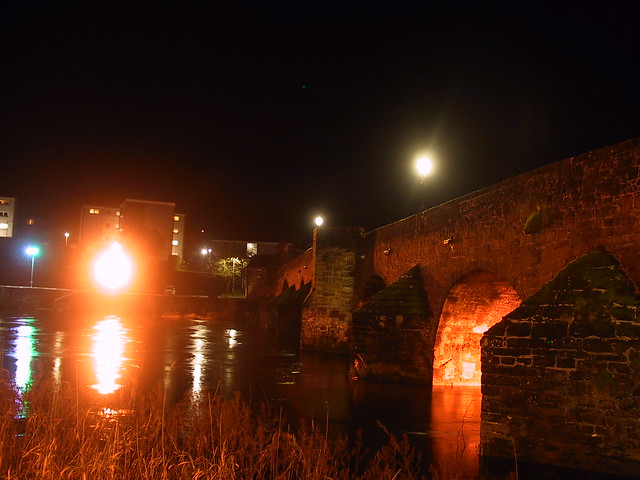
The limited dynamic range was also noticeable due to f/8 & 1/1000 speed limit. To test ISO image quality I did a set of shots of the Devorgilla bridge in crisp winter light. At 200 ISO, the bridge has pretty decent exposure at 1/1000 and f/8. At 400 ISO the exposure system had no where to go and shot the same. The shot is notably washed out by just one stop of over-exposure.

ISO
But this camera like good light. Having a camera that defaulted to 50 ISO might sound odd today but this was a stroke of genius for Canon. Sensor noise is a lot less. The 100 ISO is not bad and the 200 ISO you kinda can live with but 400 is pretty noisy. But 50 ISO is just peachy



Equally you wont get speeds above 1/500 with the 50 ISO as you’d need to get them in combo. But if depth of field bothers you due to sensor crop f/5.6 will be giving you a depth of field equivalent to about f/11-16 on a full frame camera.
Quality Setting and Colour Balance & Palette
I confess the difference between fine (default) and superfine quality is minimal but on both there is a little edging and some noise on block colour. Turn down to the lowest setting (normal) and things are obviously worse.
Colour balance on daylight shots were good. Blues are quite lush for the sky. It also coped okay with night shooting outdoors. But interesting it struggled a little under 2020’s LEDs. in some rooms pretty good but others there was an incandescent to tungsten casts. But this a camera launched in 2000 when most folks used either incandescent, CFL or neon lighting.
Optics
Optically this is pretty good stuff. Canon have been in the business of making AF compacts longer than anyone else. They were the second company to launch a AF film compact and arguably the firsts with a system we’d recognise today. Their film SureShot range was a dependable series of good cameras that lasted into the noughties selling alongside their digital siblings.
There is some chromatic purple fringing going on and you need to look but this crop of the bridge shot shows it around the lampost and it is clearly different to the sensor & compression artefacts you see round the man. But you need to look.

But you really need to zoom in. I can see this on my 24″ WUXGA LCD with the image taking up my screen. Back in 2000 the average monitor was 800×600. Now granted the shooter of a G1 more likely had a bigger XGA (1,024×768) 15″ or 17″monitor.
in terms of radial distortion this pretty good. There is tiny amount of barrel at wide angle and a tint of pincushion at the tele end. Sharpness is good.
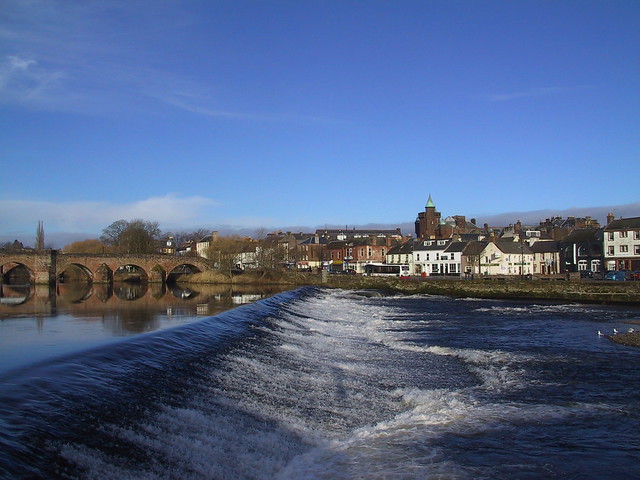
The wide end is a little weak on long shots but better than most. The tele end is actually much better than average on the long shot. Macro at wide works well but there is more distortion evident to the edges. Having close focus on macro at the tele end of 20cm, means there’s little point in using it over the wide end unless you can’t get that close it. It isn’t quite as good either.

Conclusions –
Is the PowerShot G1 still useable ?
This is a good camera. The best way to sum up is you could quite happily use this as a still camera in 2021 for web work and prints. And that is no mean feat for a 2 decade old digital.
A newer compact will be faster and have higher resolution. The dynamic range will be better and shooting 400 ISO won’t be an issue. There won’t be a weird shutter limitation, you’ll also be able to shoot useable video and use it at night. But beyond that the differences get marginal. This will certainly stand up well in normal conditions against sub £100 compacts bar those points. It also offers a massive amount of user control
Alternatives ?
It out performs the early noughties consumer digitals like the 2005 Nikon Coolpix 5600. The Canon Powershot A80 has similar feature and is cheaper. But when working (sensor failure is a real issue) it just wasn’t quite the same. The Samsung L830 from 2008 on paper offers more with it’s 8.3 MP sensor and more slimline modern looks but again just doesn’t match in the results department.
Granted you can pick up a better more midlevel camera like the 2009 Panasonic Lumix DMC-TZ7 for less with a better Leica lens and sensor, movie mode and performance. But that has much less in the way of user control and is less robust. But the G1 has a tad more history.
The Killer Of Film ?
And in its day it should have been a wake up call to the film camera industry. This is a camera that could compete and exceed 35mm compacts (with the exception of speed). Sure the G1 Launch RRP wasn’t cheap at $1100USD.
But things were going to get cheaper for digitals. All of the models discussed above had a launch price below $400USD and the Samsung was well under 200 British quid.
But ironically the year this analogue killer arrived, The harbringer of doom also arrived for the digtal compact.

Sharp launched the J-SH04. This was the first mobile phone with a camera that could directly share images to other phones (well okay other J-phones). That marked the first shots of the rise of the camera phone.
Notes & resources
Canon still have the manual on the support pages for the G1 on their US site. It also features in Canon’s camera museum. As well as the DPReview of this in 2000, Steve’s Digicams reviewed it at launch
* File size was based on the average of a sample of 50 shots on default jpeg image quality -full resolution and medium detail

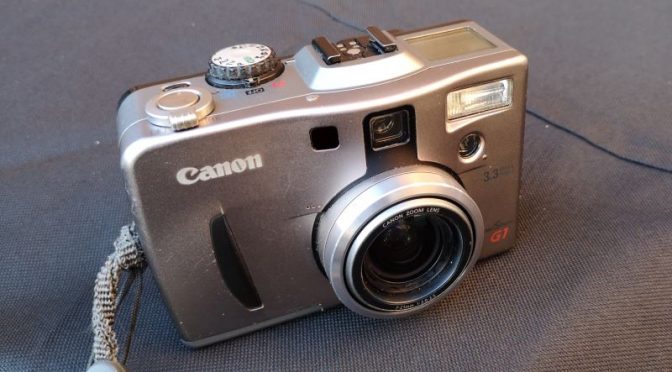

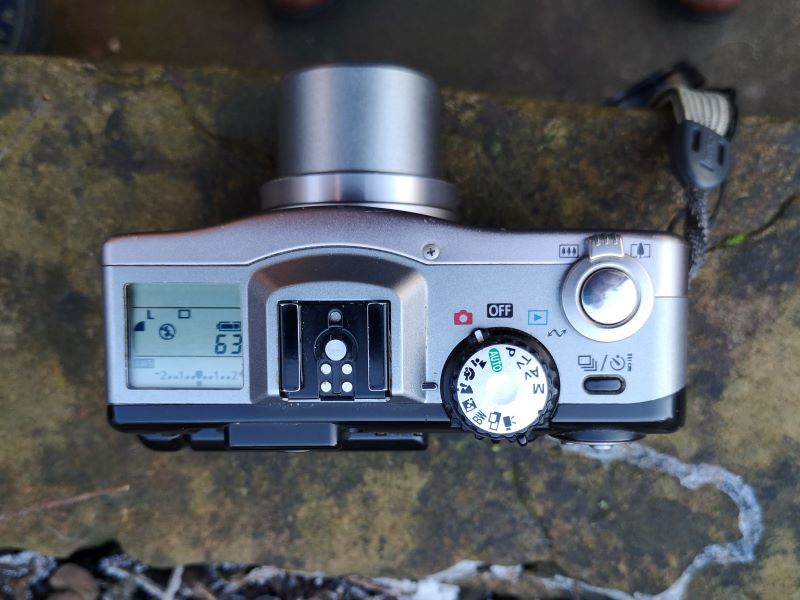
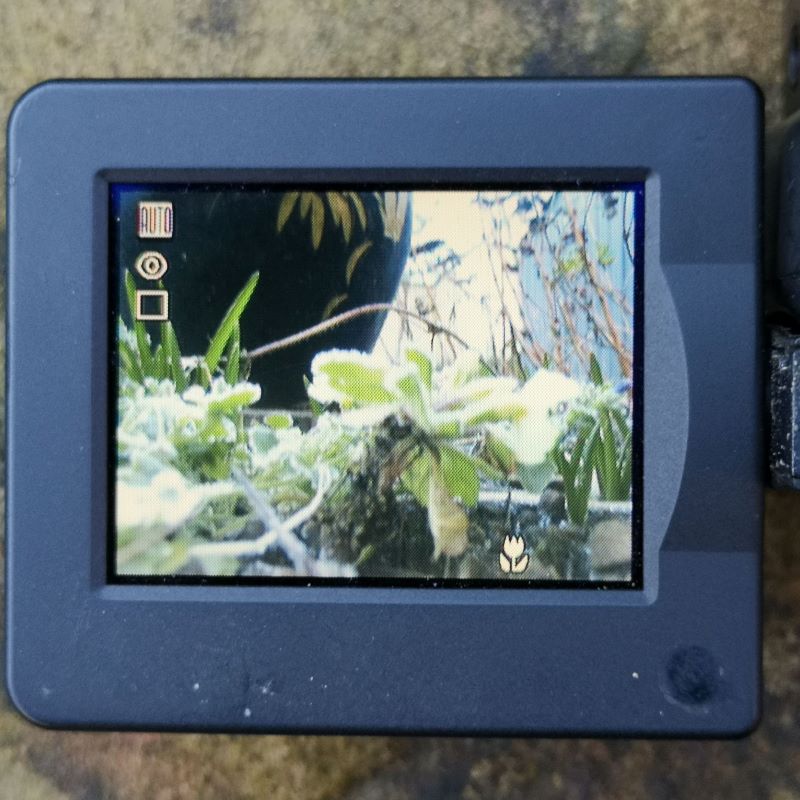
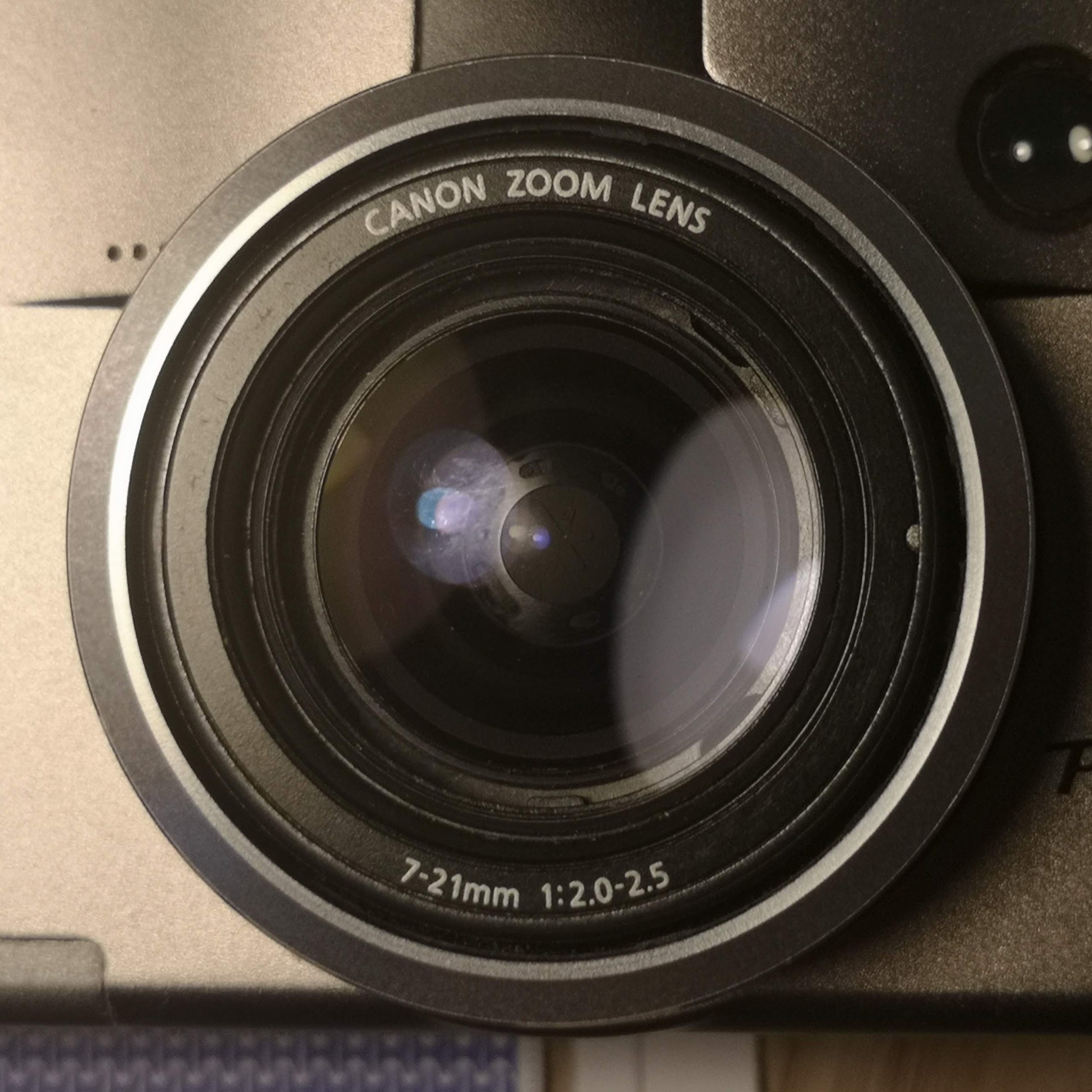




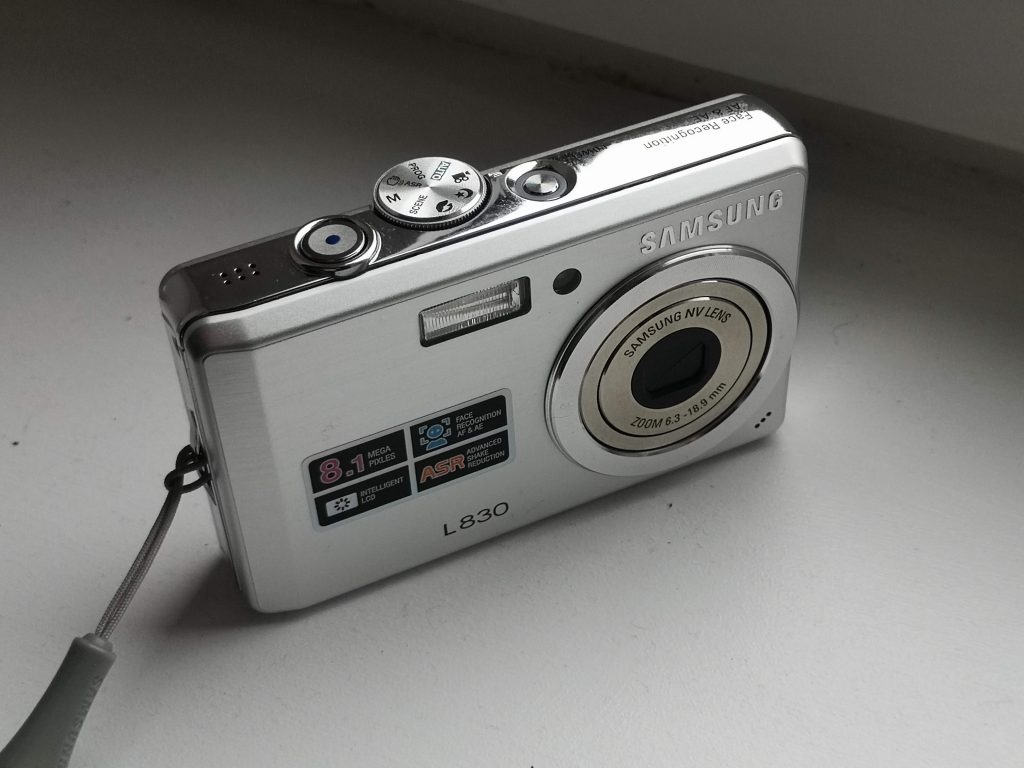
Alan, for me it was the G2, which I acquired, if memory serves, in January, 2003. My interest in film photography had been waning since the end of the 1990’s and was complete by 2000 when I gave up doing my own D&P, and which for me was the end of 40 years doing it. For the next two years I was content with High Street processing, with more interesting shoots being developed by a specialist lab.
I’d been thinking about digital and wasn’t impressed with the early efforts, but this ended when Canon issued a special edition black G2 with the 1gb microdrive. It was this or the newer G3, both with 4mp sensors. Given the horrendous price of CF cards at the time, the G2 package won me over. And I wasn’t disappointed. I was a digital convert. No more faff and kerfuffle getting the darkroom ready, no wet chemicals, no working under the safelight for a couple of hours or more, no clearing up afterwards and waiting for the prints to dry. Daylight had replaced my darkroom.
I could edit images to my heart’s content, see the results immediately, and print, and up to A4 with no problem with my then Canon S900 printer, and better than from 35mm colour neg film. And I could see the images on a monitor obviating the need to print. If I had wanted b&w prints, then my 6×6 and 5×4 negs would have been superior, but for colour, even the 4mp sensor was delivering what I wanted.
There is still a place for film as many want the look that only film can give, and this is what they’re after. Sadly, it comes with increased costs which for many means far fewer images taken, and the ever present problem of a favourite emulsion being discontinued by the manufacturer. And film does have a major feature over digital – permanence. Providing it is processed and stored properly, it has a proven record for longevity. For most of us, the stability of the digital image is at best only proven for 20 years to date, and even this may only hold true if we transfer them to other storage drives at intervals, and providing we can can continue to access the drive.